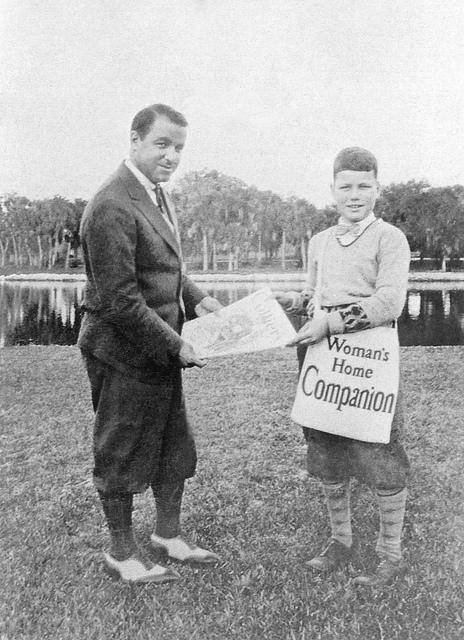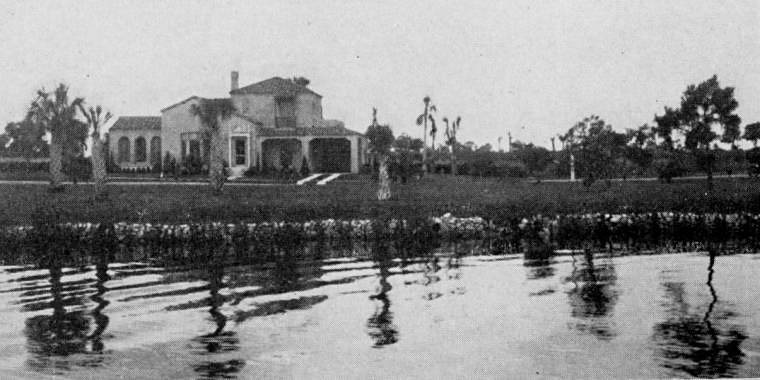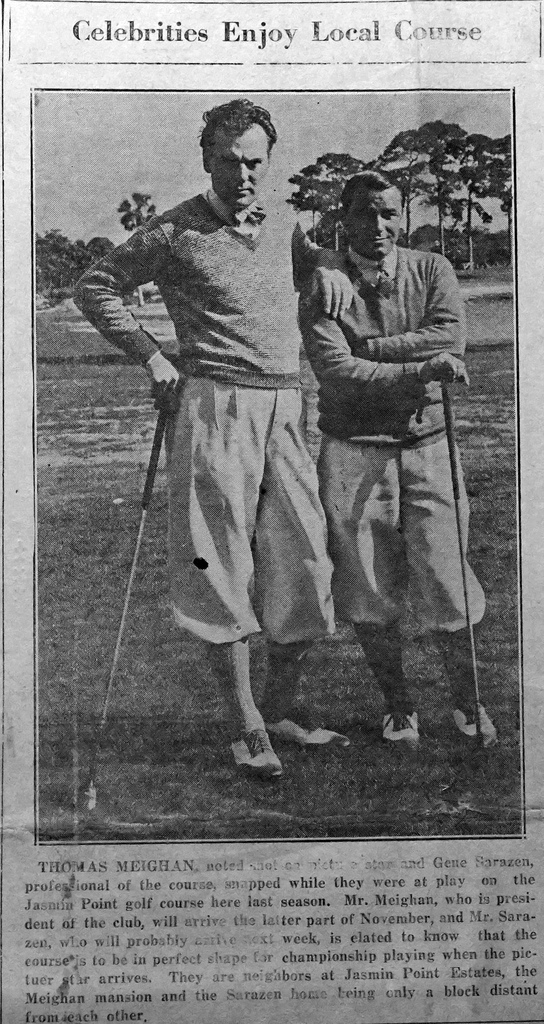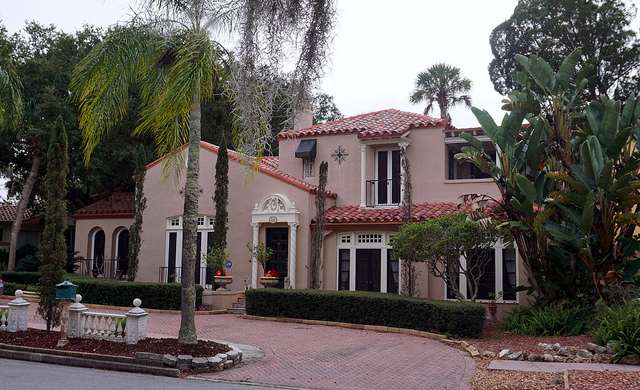HISTORY OF PASCO COUNTYGene Sarazen in New Port Richey Gene Sarazen (1902-1999), one of the greatest golfers of all time, invented what is considered to be the first true sand wedge (he called it the sand-iron) in 1931. He built the prototype in a small machine shop in New Port Richey in 1931. According to his daughter, “What my dad did was design the first modern sand wedge, with a steel shaft, markings on the clubface and the amount of flange on it that is still widely used today.” A 2010 web article by Mary Ann Sarazen is here. Sarazen wintered in a subdivision known as Jasmin Point. Adjoining the subdivision, a golf course was laid out. On Dec. 20, 1927, the Dade City Banner reported:
According to Glen Dill, the nine-hole golf course opened in February 1929, “extending from the river westward across the present U. S. 19, south of the bridge—Avery Road bisects where most of the course had been, the lake hazard is still behind Richey Motel.” Sarazen wrote that the “New Port Richey course wasn’t a very good one, but it did have one excellent trap, right behind my house. It was there that I tried out my sand-iron, hitting thousands of shots each week, making adjustments back in the machine shop….” Sarazen was born Eugenio Saraceni in Harrison, N. Y., and died in Naples, Florida. Gene Sarazen To Build Home at Jasmin Point (1927)Noted Golf Professional Will Make New Port Richey His “Permanent Home” AddressWill Supervise Construction and Manage New Jasmin Point Golf ClubThis article appeared in the New Port Richey Press on Aug. 26, 1927. Word has just been received from Warren E. Burns now in New York City that he has sold to Gene Sarazen, the noted golf professional, winner of the golf championship of the United States in 1922 and recent winner of the Long Island championship, a residential plot as Jasmin Point, opposite the property recently purchased by Thomas Meighan. Mr. Sarazen is having plans prepared for the immediate construction of an attractive residence on the property just purchased, to cost about $20,000, which will be occupied by Mr. Sarazen. A contract has also been signed whereby Mr. Sarazen will supervise the construction and manage the new Jasmin Point Golf Club, and his entries in all winter tournaments from now on will carry New Port Richey’s name as his home course. Mr. Sarazen is best known as the winner at the Skokie Country Club, Glencoe, Illinois, in 1922, when only 20 years old, of the open championship of the United States and in the same year, at Oakmont, Pa. of the Professional Golf Championship of the United States. During the recent championship on the same course, he finished only one point behind the winner, almost performing the unusual feat of winning the championship twice over the same course. Within the past two weeks, Mr. Sarazen won the championship of Long Island, New York, by 11 strokes, as representative of the Fresh Meadow Country club of Flushing, N. Y. where he is employed during the summer. Both Mr. and Mrs. Sarazen have visited New Port Richey and have many friends among our townspeople, who will welcome them as permanent residents. The addition of Mr. Sarazen’s name to the growing list of notables residing in New Port Richey means much to the entire city and is of particular value in connection with the establishment of sports of all kinds for the entertainment of our visitors.  AP News Story (1932)The following is an Associated Press news story from Oct. 20, 1932. TAMPA—Two $40,000 damage suits have been filed in federal courts here by Gene Sarazen, American and British open golf champion, in an effort to collect for three years of service as professional golf instructor at the Jasmin Point Golf club at New Port Richey. One of the suits was directed against the club corporation and the other against Warren E. Burns, New Port Richey developer who headed the club and Jasmin Point estate, a corporation interested in sale of lots adjacent to the golf course. Edwin Thomas, Sarazen’s attorney, said the suits were based on a contract signed between Sarazen and the club in 1927 which guaranteed him an income of $20,000 for three years beginning Jan. 1, 1928. The income failed to materialize, the attorney said Sarazen contended, and the suits were brought. Golf Champ Sarazen’s Kindness Remembered (1999)This article appeared in the St. Petersburg Times on May 23, 1999. By RICHARD VERRIER New Port Richey residents fondly recall the man who helped develop the city’s first golf course. David Luikart Sr. was only 5 years old at the time, but he still remembers the man with the fancy clothes who invited him onboard the Goodyear Blimp. “He was going to take me up, and my mother vetoed that pretty quick,” said Luikart, now 74. The man was young golf celebrity Gene Sarazen. The occasion was the grand opening of the Jasmine Point Golf Club, the nine-hole golf course that Sarazen helped develop. The time was February 1929. “He liked kids,” said Luikart, whose brothers caddied at the club. “He was a fine gentleman.” Sarazen’s recent death at age 97 evoked fond memories from those who knew him in New Port Richey – the town where he owned a home, helped build the city’s first golf course and invented what would become his most enduring contribution to golf: the sand wedge. In recognition of Sarazen’s ties to New Port Richey, the City Council voted last week to nominate Sarazen for a Great Floridian 2,000 award. The Florida League of Cities award would pay for a plaque in memory of Sarazen that might be placed at the new overlook to Sims Park at the Main Street Bridge. Sarazen, a native of Harrison, N.Y., already was a rising golf star by the time he came to New Port Richey in 1926. He had won the 1922 U.S. Open as a 20-year-old, and the 1922 and ’23 PGA Championships. Local developers George Sims, Warren Burns and James Becker recruited him to help build a golf course at the Jasmine Point subdivision. Sarazen built a two-story, Spanish-style home on River Road North. He soon befriended his neighbor across the river, Thomas Meighan, the silent movie star who had just opened the Meighan Theater. Meighan wasn’t an especially good golfer. “He’d throw his clubs off in the palmetto bushes,” said real estate broker John Grey, whose father, James, was a caddy at the Jasmine Point club. But Meighan, who eventually became the golf club’s president, had ambitious plans for New Port Richey and wanted Sarazen to be a part of them. “He was determined to make this a Hollywood winter community,” Grey said. The golf course, billed as a course for the average player, opened in 1929 with nine holes. It ran along Avery Road and what is now both sides of U.S. 19. The ninth hole cut behind what is now the HoHo Chinese restaurant, where a pond is the only reminder of the now- defunct course. The Jasmine Point Club closed after the Depression. Sarazen sold his home in 1934, but not before leaving his greatest legacy: the sand wedge. Like most golfers, Sarazen had difficulty with sand traps. He was determined to find a solution. He spent countless hours soldering irons in his home and at Scofield-Huddleston Garage (now a three- story office building) at the corner of Grand and Gulf boulevards. With his new club, Sarazen went on to win the U.S. Open and the British Open in 1932. Despite his celebrity status, Sarazen enjoyed mingling with city residents and helped popularize golf among local youth. “He’d do anything to promote golf,” Grey said. “He’d give away clubs.” “He helped develop a little golf course around Orange Lake so the children could have a place to play,” said New Port Richey native Frances Mallett, who remembers playing at the course when she was 12. “He was trying to get kids interested in golf.” One day, in the early 1930s, Mallett said, she and other students at her elementary school were let out early to watch a parade down Main Street in honor of Sarazen, who had just won a major golf tournament. “We were very much impressed with his knickers (golf pants), his big check and his big, fancy open touring car,” said Mallett, past board member of the West Pasco Historical Society. Allan Safranek Sr., former owner of Richey Realty, said he occasionally caddied for Sarazen and “shagged” or retrieved balls for him when he was 12. “He was just constantly practicing with his irons” at the Jasmine Point Golf Club, Safranek said. “He would shoot all these balls and we would go retrieve them. He practiced, practiced and practiced.” Safranek also remembers Sarazen for his generosity. “He tipped good, 50 cents. And boy, I mean, that was something,” said Safranek, 81. “Meighan gave you a dime or quarter and would make you get his balls in the water. “He (Sarazen) was so good to caddies because he was a caddy once. He treated all caddies like they were human beings. He was just a wonderful guy, and I never saw him without his knickers.”  CNNSI.COM ArticleIn the winter of 1932 Sarazen was living in New Port Richey on the west coast of Florida and taking flying lessons in a small Stinson plane. One day while taking off, he watched the tail of the plane drop as the plane rose and wondered whether a club might not have a similar effect on a ball in sand. “It gave me a funny sensation,” he says. “I called the Wilson Company and asked them to send me 12 niblicks, and I went to the hardware store and bought solder and rasps and files and spent four or five hours each day filing away till I got it just right.” That winter Sarazen made his first money with his new weapon, betting gullible golfers like Howard Hughes $5 he could get up and down in two from traps. By the time the British Open began in June 1932, he was ready. Fearful that the Royal and Ancient, the game’s governing body in Britain, would ban the club, Sarazen told his caddie to replace it in the bag blade down, and at night he smuggled it into his hotel room under his polo coat. “We waltzed around,” says Sarazen, chuckling at the memory. “I was seven or eight strokes in the lead at one time and I won by five.”  |
